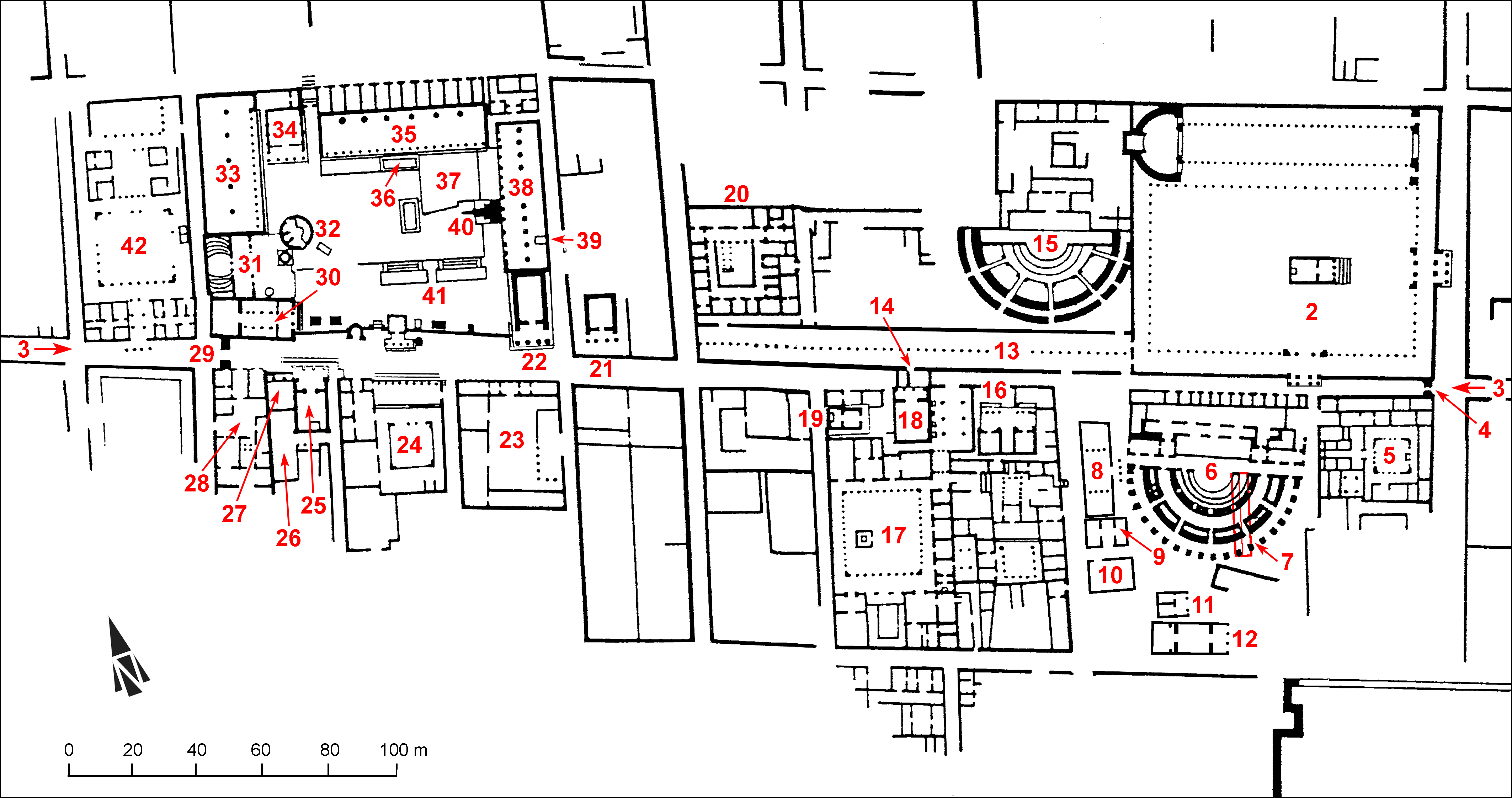EpiDoc XML:
GVCyr0402
Trismegistos ID:
738933
Source description
Support: Fragmentary white marble panel, broken off on all sides but at right (w: 0.15 × h: 0.17 × d: 0.02).
Layout: Inscribed on the face.
Letters: 0.02, carefully cut; alpha with low bar, tall beta with two small loops, xi with central hasta, smaller circular letters, dissymmetrical pi, rho with small loop, non-slanting sigma, phi with flattened loop, omega with nearly closed horse-shoe shape.
Date: Second half of second century BC (lettering).
Findspot: Found on January 21st, 1917 at Cyrene ➚: on the agora.
Place of origin: Findspot.
Last recorded location: Probably lost.
Text constituted from: Transcription from previous editor.
Bibliography
†Oliverio, SECir, 80, fig. 67; GVCyr 040 ➚.
Text
| [---]λ̣αι
| [---] ς̣ ἅλλοις Βαττιά|[δαις ---]ωμεν ἐπ᾿ εὐϊέροις
| [--- σ]ύναιμον. (vac. 9?)
| (5) [---c. 1 - 2] ν̣, ἅναξ, ἄιδω ἰὴ ἰὼ ἰὲ Παιάν,
5 | [--- θ]ῦ̣μα ἀνάκτων σὺν
| [---]+ο̣υ μόλ᾿ εὕφρων τᾶιδε πό | [λει ---] φίλω̣ι δυνάσται
| [------ ἰὴ ἰὼ ἰὲ] Παιάν | [------?]
Apparatus
French translation
[---] aux autres Battiades [---] nous [---] sur les [---] sacrés [---] du même sang. [---], seigneur, je chante iè iô ié Péan !
[---] la victime offerte par les seigneurs avec [---]. [---] viens, bienveillant pour cette cité [---] au cher souverain [---] iè iô ié Péan ! [---].
English translation
[---] to the other Battiadae [---] we [---] on the sacred [---] of the same blood. [---], lord, I am singing ie io ie Paean!
[---] the victim offered by the lords with [---]. [---] come, kindly towards this city [---] to the dear ruler [---] ie io ie Paean! [---].
Italian translation
[---] agli altri Battiadi [---] noi [---] sul sacro [---] dello stesso sangue. [---], signore, io canto iè iò ié Peana!
[---] la vittima offerta dai signori con [---]. [---] vieni, con benevolenza, verso questa città [---] al caro sovrano [---] iè iò ié Peana! [---].
Commentary
Pugliese Carratelli found in †Oliverio's papers the photograph and transcription, without further comment of this fragmentary paean. Pugliese found out and added the date and place of the find.
The lettering is very similar with that of IGCyr0111002. The 'lord' of text-line 6, with an unclear ending for the appended adjective, may be a nominative plural or a dative singular, the latter being more plausible if this is an appeal to the god in favour of the king. One Ptolemaic ruler (or several) would be possibly Ptolemy IX alone or with one Cleopatra. However other rulers are also possible. The mention of one or more 'ruler(s)' at line 8 should be related to them again. It is even a plausible guess that σύναιμον at line 4 already relates to one Cleopatra as sister-queen. It is a tantalizing guess to connect this poem with the celebrations scheduled in IGCyr0111002. Anyway the use of ἀνάκτων is a clever way of pointing out that the rulers were divinised and nearly equal to Apollo, the ultimate ἄναξ.
At any event, the Battiadae mentioned at line 2 cannot be the same 'rulers' as those mentioned below. The former were plausibly remembered here as traditional figures of the Cyrenaican history. In the lost part, one would have been mentioned by name, perhaps the Founder; this would explain the use of ἄλλοις.
At l. 3, the final ΩΜΕΝ might be a 1st person plural indicative of a present in -όω or of a subjunctive of many verbal stems as well as a Dorian infinitive. Oliverio's restoration might only be the subjunctive. We prefer to leave the question open.
At l. 6 the hiatus is allowed on behalf of the ancient digamma. A long syllable is requested before the lacuna, thus our restoration of θῦμα. Apollo was probably requested to agree the sacrifice offered by the king(s).
At l. 7 the negative particle would not be grammatically acceptable with an imperative. Nor would it be desirable with an aorist without augment for the resulting meaning of the sentence would not fit a laudatory context such as this one. ΟΥ should thus rather be the end of a noun or adjective of the 2nd declination.
At l. 8 a long syllable should precede the vestiges. Thus ὦ to fit either a nominative plural or τῶι (or a possessive adjective) to fit a dative singular, which are the two possible readings because of the broken off circular letter.
Metrical analysis: fragmentary as those verses are, it is impossible to offer a full reconstitution of the metrics. The poem being obviously a paean, it should consist of dactylo-trochaic sequences that we tried to trace. Because of the space at line 4, we suspect the layout to follow the division into kola; however we can be sure that two successive kola belong to the same verse only if a word runs over their common limit, which is the case only between text-lines 2-3 and 7-8. So the numbers given for the verse lines should be considered arbitrary. In order to respect the desirable succession of short and long syllables, we rejected Oliverio's τοῖς at l. 2 and supposed a long syllable at the end of the lacunae at lines 5, 6, 8 and 9.
CC BY-NC-SA 4.0 Deed Attribution-NonCommercial-ShareAlike 4.0 International License.
All citation, reuse or distribution of this work must contain a link back to DOI: https://doi.org/10.60760/unibo/igcyrgvcyr2 and the filename (IGCyr000000 or GVCyr000), as well as the year of consultation.


